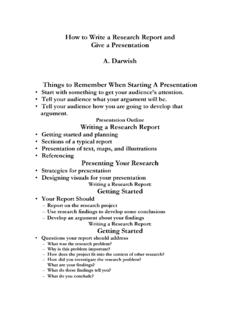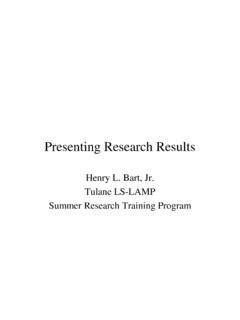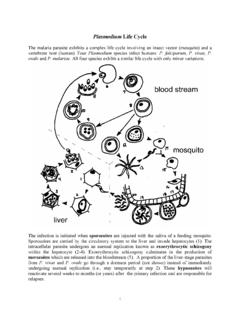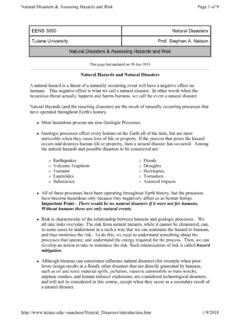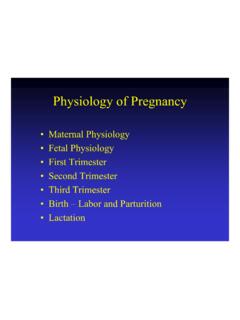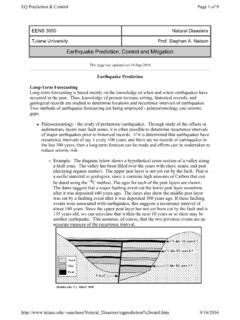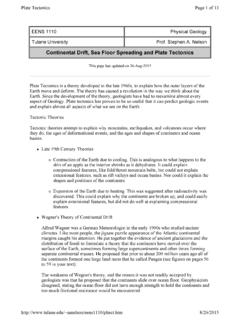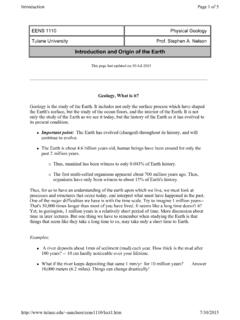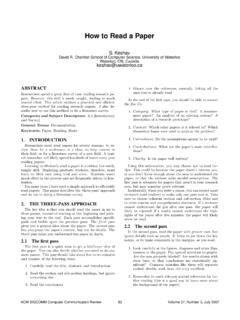Transcription of Whitesides' Group: Writing a Paper**
1 _ _ _ _ _ _ _ _ _ _ _ _A DVANCED. MATERIALS. whitesides ' group : Writing a paper **. By George M. whitesides *. 1. What is a Scientific paper ? do not agree on the outline, any text is useless. Much of the time in Writing a paper goes into the text; most of the thought A paper is an organized description of hypotheses, data and goes into the organization of the data and into the analysis. It conclusions, intended to instruct the reader. Papers are a cen can be relatively efficient in time to go through several (even tral part of research. If your research does not generate many) cycles of an outline before beginning to write text;. papers, it might just as well not have been done. "Interesting Writing many versions of the full text of a paper is slow. and unpublished" is equivalent to "non-existent". All Writing that I do-papers, reports, proposals (and, of Realize that your objective in research is to formulate and course, slides for seminars)-I do from outlines.
2 I urge you to test hypotheses, to draw conclusions from these tests, and to learn how to use them as welL. teach these conclusions to others. Your objective is not to "collect data". A paper is not just an archival device for storing a com How Should You Construct an Outline'? pleted research program; it is also a structure for planning your research in progress. If you clearly understand the pur The classical approach is to start with a blank piece of pose and form of a paper , it can be immensely useful to you in paper , and write down, in any order, all important ideas that organizing and conducting your research. A good outline for occur to you concerning the paper . Ask yourself the obvious the paper is also a good plan for the research program. You questions: "Why did I do this work?"; "What does it mean?";. should write and rewrite these plans/outlines throughout the "What hypotheses did I mean to test?
3 "; "What ones did I. course of the research. At the beginning, you will have mostly actually test?"; "What were the results? Did the work yield a plan; at the end, mostly outline. The continuous effort to un new method of compound? vVhat?"; "What measurements derstand, analyze, summarize, and reformulate hypotheses on did I make?"; "What compounds? How were they character . paper will be immensely more efficient for you than a process ized?". Sketch possible equations, figures, and schemes. It is in which you collect data and only start to organize them essential to try to get the major ideas. If you start the research when their collection is "complete". to test one hypothesis, and decide, when you see what you have, that the data really seein to test some other hypothesis better, don't worry. Write them both down, and pick the best 2. Outlines combinations of hypotheses, ohjectives, and data.
4 Often the objectives of a paper when it is finished are different from The Reason for Outlines those used to justify starting the work. Much of good science is opportunistic and revisionist. I emphasize the central place of an outline in Writing When you have written down what you can, start with an . papers, preparing seminars, and planning research. I espe other piece of paper and try to organize the jumble of the first cially believe that for you, and for me, it is most efficient to one. Sort all of your ideas into three major heaps (1-3). write papers from outlines. An outline is a written plan of the organization of a paper , including the data on which it rests. 1. Introduction You should, in fact, think of an outline as a carefully orga . nized and presented set of data, with attendant objectives, Why did I do the work? What were the central motivations hypotheses, and conclusions, rather than an outline of text.
5 And hypotheses? An outline itself contains little text. If you and I can agree on the details of the outline (that is, on the data and organiza . tion), the supporting text can be assembled fairly easily. If we 2. Results and Discussion What were the results? How were compounds made and characterized? What was measured? ["'J Prof. G. M. whitesides Department of Chemistry and Chemical Biology 3. Conclusions Harvard University Cambridge, MA 0213& (USA). E-mail: What does it all mean? What hypotheses were proved or ["'*] The text is based on a handout created on October 4, 19&9. disproved? What did I learn? Why does it make a difference? Adv. Mater. 2004, 16, No. 15, August 4 001: 002 2004 WILEY-VCH Verlag GmbH & Co. I<CaA, Weinheim 1375.. DVAN CED..A ----: :../W_h_it_e_si_d_es_' :p_:_W_r_it~in~g::. :a::!p:..::.er MATERIAL. Next, take each of these sections, and organize it on yet The justification for these objectives: Why is the work im.]
6 Finer scale. Concentrate on organizing the data. Construct fig portant? ures, tables, and schemes to present the data as clearly and Background: Who else has done what? How? What have compactly as possible. This process can be slow-I may sketch we done previously? a figure five to ten times in different ways trying to decide Guidance to the reader: What should the reader watch for how it is most clear (and looks best aesthetically). in the paper ? What are the interesting high points? What Finally, put everything-outline of sections, tables, sketches strategy did we use? of figures, equations-in good order. Summary/conclusion: What should the reader expect as When you are satisfied that you have included all the data conclusion? In advanced versions of the outline, you (or that you know what additional data you intend to collect), should also include all the sections that will go in the and have a plausible organization, give the outline to me.
7 Sim Experimental section (at the level of paragraph subhead . ply indicate where missing data will go, how you think ings) and indicate what information will go in the Micro . (hypothesize) they will look, and how you will interpret them film section. if your hypothesis is correct. I will take this outline, add my opinions, suggest changes, and return it to you. It usually takes 5. Results and Discussion four to five iterations (often with additional experiments) to agrcc on an outline. When we have agreed, the data are usual TIle results and discussion are usually combined. This sec . ly in (or close to) final form (that is, the tables, figures, etc., in tion should be organized according to major topics. TIle sepa . the outline will be the tables, figures, .. in the paper ). rate parts should have subheadings in boldface to make this You can then start Writing , with some assurance that much organization clear, and to help the reader scan through the of your prose will be used.
8 Final text to find the parts of interest. The following list The key to efficient use of your and my time is that we start includes examples of phrases that might plausibly serve as exchanging outlines and proposals as early in a project as pos section headings: sible. Do not, under any circumstances, wait until the collection Synthesis of Alkane Thiols of data is "complete" before starting to write an outline. No Characterization of Monolayers project is ever complete, and it saves enormous effort and Absolute Configuration of the Vicinal Diol Unit much time to propose a plausible paper and outline as soon as Hysteresis Correlates with Roughness of the Surface you see the basic structure of a project. Even if we decide to Dependence of the Rate Constant on Temperature do significant additional work before seriously organizing a The Rate of Self-Exchange Decreases with the Polarity of paper , the effort of Writing an outline will have helped to the Solvent guide the research.
9 Try to make these section headings as specific and infom,a . tion-rich as possible. For example, the phrase "The Rate of Self-Exchange Decreases with The Polarity of The Solvent" is The Outline obviously longer than "Measurement of Rates", but much more useful to the reader. In general, try to cover the major What an outline should contain: common points: Synthesis of starting materials Characterization of products 1. Title Methods of characterization Methods of measurement 2. Authors Results (rate constants, contact angles, whatever). In the outline, do not write any significant amount of text, 3. Abstract but get all the data in their proper place: Any text should sim . Do not write an abstract. That can be done when the paper ply indicate what will go in that section. is complete. Section Headings Figures (with captions). Schemes (with captions and footnotes).
10 4. Introduction Equations Tables (correctly formatted). The first paragraph or two should be written out complete Remember to think of a paper as a collection of experimen . ly. Pay particular attention to the opening sentence. Ideally, it tal results, summarized as clearly and economically as possible should state concisely the objective of the work, and indicate in figures, tables, equations, and schemes. The text in the why this objective is important. paper serves just to explain the data, and is secondary. The In general, the Introduction should have these elements: more information can be compressed into tables, equations, The objectives of the work. etc., the shorter and more readablc the paper will be. 1376 2004 WILEY VCH Verlag GmbH & Co. KGaA, Weinheim Adv. Maler. 2004, 16, S, August 4. :./_W_h_i_te_s_id_e_s_'_G_ro_u-,p_ :.g.

